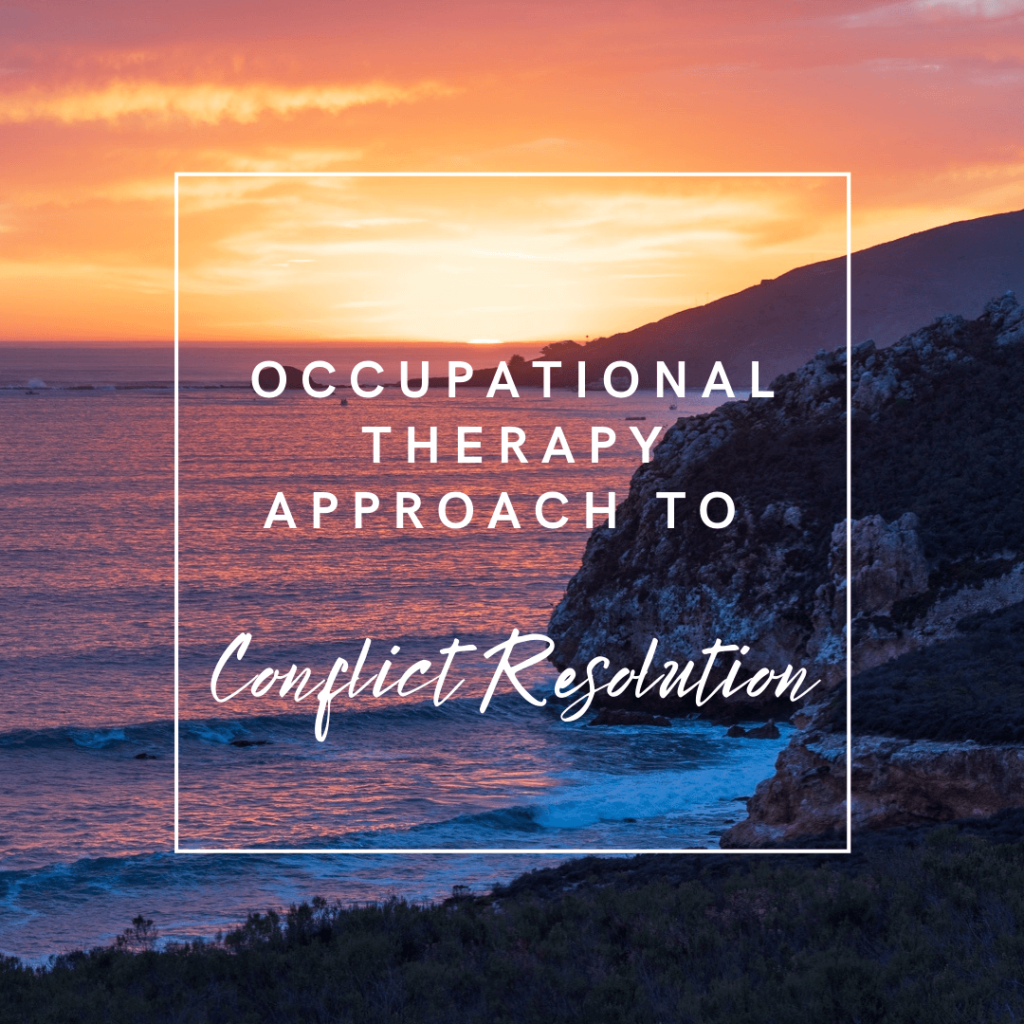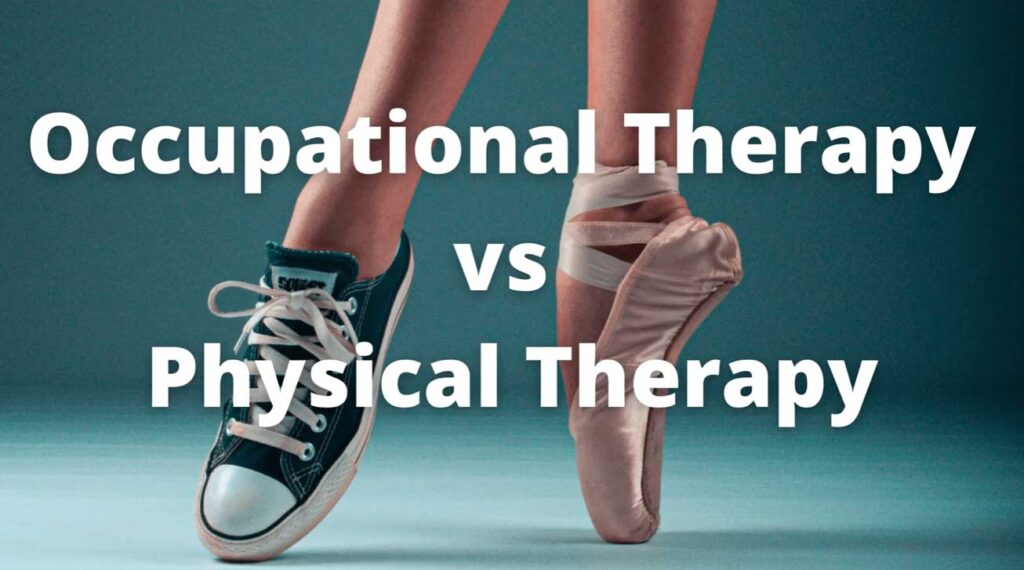When you think about occupational therapy, conflict resolution usually isn’t the first thing that comes to mind. Normally, we think of meaningful activities and interventions that help people reach their goals.
What about when life goals and objectives aren’t being met because of conflict in relationships at home, work, and organizations. Can occupational therapy be useful in bridging relationship gaps to increase well being and provide a more fulfilling life?
I’m writing this article in hopes that you might think about Occupational Therapy a little differently, that you might see that occupational therapy can use different approaches to facilitate more meaningful outcomes.
In this non-traditional approach, I’ll discuss why occupational therapy should be used to improve relationships, and how it can be implemented.

Why OT should be in the field of managing conflict
To read a more in-depth article on why OT should be in the field of conflict resolution and peace-building, check out my other article here.
In summary, OT should be in this field, because OT helps others whose lives have lost meaning due to depression, anxiety, emotional pain, trauma, or fear from relationship conflict.
This includes conflict with families, partners, friends, coworkers, and organizations.
What does Occupational Therapy have to do with resolving conflict?
Think about the patients you see on a daily basis. Are they experiencing conflict with hospital staff, doctors, or family members.
Are they experiencing depression from pain or other personal struggles?
It’s not just our clients experiencing conflict. In many ways, all of us experience it with ourselves or with others. We experience conflict in our homes, with our families, coworkers, and organizations.
Occupational therapy seeks to improve:
- The well being of others
- Social Participation
- Self Esteem
- Sense of belonging
- Meaningful occupations
- Mental and emotional health
OT’s role in relationship conflict
Occupational therapy has an important role in relationship conflict because of its unique client-centered approach. OTs don’t just treat a diagnosis; they treat people.
This client-centered approach is exactly why OT is already in the field of conflict resolution and improving relationships. When we see others more holistically we understand that multiple factors may contribute to life struggles.
One of these factors includes relationships with others. Relationships are an important aspect of our well being and who we are.
OTs already work on methods to build peaceful relationships when they incorporate coping strategies, social participation, and other meaningful activities that can help restore these relationships.
Now that we understand occupational therapy’s role in resolving conflict, let’s look at how OT can transform conflict.
Occupational therapy as a means to conflict transformation

The following approach to conflict comes from the books Dangerous Love, The Outward Mindset, and The Anatomy of Peace.



To address how occupational therapy can be used to transform conflict, we first need to understand conflict.
According to Chad Ford, author of Dangerous Love, Not all conflict is bad. Conflict can be positive or negative. Positive conflict can be constructive and lead to peaceful outcomes.
We have positive conflict when we collaborate to find solutions and see others for who they are and see their potential.
Negative conflict happens when fear is introduced. This leads to defensive thoughts or feelings.
Negative conflict happens when we become the victim and blame others. This happens as we see others as objects rather than people.
Occupational Therapy is about helping others overcome their fears by engaging in meaningful activities, but sometimes it’s more important to first help our clients overcome their fears.
What are our client’s fears?
Our clients fears are not singular. They may have feelings of shame from just being in a hospital or other facility. These feelings may be exacerbated as they are confined to a hospital bed and fitted with an oversized gown.
They may have fear of pain, trauma, or surgery. They may fear that no one is listening or understanding their needs.
They may have fear that they won’t get better, that their home affairs won’t be sorted, or that their life will never be the same.
As occupational therapists how can we help people with their fears?
Do we start by teaching them an activity that might be meaningful to them? Better yet, do we teach them behavioral techniques or compensatory strategies to help them overcome these fears?
Before we can teach an behavioral technique or activity we must first prepare clients for these interventions.
Compensatory strategies or coping skills can be a helpful way to educated clients on methods to alter their thoughts or behaviors, but sometimes the act of teaching someone how to think or behave can have a negative outcome.
When we teach or educate a client on ways to change their thoughts or behaviors, we make assumptions that the client needs our help because of his or her problem or inadequacy.
As this happens, we see the client by their diagnosis and not by who they are.
This may cause our client to have feelings of fear and defensiveness. As a result they may become more disengaged.
This not only happens with our clients, it happens at home with our families, at work in our communities, and throughout the world.
How do we help others get out of this mindset?
Changing others starts with changing ourselves
I recently was treating a patient in the hospital. Before entering the room, I asked the nurse if it would be okay to see the patient. The nurse responded with these two words, “good luck!”
I entered the room with a little anxiety, but I was up for the challenge. As I worked with the patient, I decided to ask what wasn’t going well for her. She told me all about her personal challenges and why she had been acting negative to the staff.
She said this wasn’t her normal behavior, but she felt like nothing was going to get better, and no one was really helping her.
I was quick to teach her ideas to cope with her stress. I taught her compensatory techniques, and before I left, I talked to her about having positive thoughts and consider having a gratitude journal.
I’ll always remember her response. In a kind way she said, “I don’t mean to be rude, because I think you’re a good person, but when you tell someone how they ought to behave, it makes them feel inferior, and it doesn’t help them want to change.”
I was shocked by her response and speechless as nursing staff and family members in the room where waiting for my response.
I felt fear and defensive, but instead of acting defensively, I decided at that moment to see her as a person. I decided to apologize. I told her that I was sorry, and she was right about the way I was treating her.
The rest of the day I thought about how I was acting, and how I was treating her. She was right. I wasn’t being client-centered, and I wasn’t seeing her as a person. I was seeing her and treating her as a diagnosis.
The next day, I decided to completely change my approach. I decided to not focus on my needs for therapy, but I really tried to listen this time and understand her needs, wants, and goals.
As a result, she started to open up and began to confide in me.
She told me that I was the only person who really took the time to listen and understand her. As a result, she was more willing to participate in therapy.
When we try to change others, they can become withdrawn and resistive. Cognitive behavioral therapy can be helpful, but if we don’t help people feel important, safe, and understood, therapy doesn’t work.
The pathway to building peace is through love
Building peace and bridging gaps with our clients, spouses, children, coworkers, or organizations starts with looking outward rather than inward. When our goals are no longer self driven and focused on ways to understand others, we will find that they will have a desire to change.
We can do this by seeking to understand their goals and objectives.
When conflict is full of fear we become defensive and begin to blame and justify our actions. We give excuses for how we behave and become the victim. By becoming the victim, we have less choices and give our power to others.
Alternatively, when we choose to show love toward others, and see them for who they really are, we empower ourselves and become the creator of our circumstances. Being the creator gives us more choices.
You might be thinking it’s nice to be kind, but love is weak and passive and when you act this way people will take advantage of you.
According to Chad Ford, this kind of love is not weak or passive, it’s dangerous. When we put forth effort to understand others and become intensely curious about them, their goals, wants, and needs, we are putting forth hard work and effort.
When we stop thinking of ourselves, becoming defensive, and trying to change others we take on an aggressive approach to building the relationship.
This kind of love is not weak, because it requires patience, risk, and can require great sacrifice for the sake of the relationship.
Chad Ford explains that this type of love is the only way to transform conflict. He states, “Dangerous love isn’t about conformity of giving in. It’s about caring enough about a person that their needs matter as much to me as my own and being committed to finding ways to get all of our needs met.”
As we take on this challenging and selfless behavior we become transformed in the relationship. We no longer focus on “my needs”, because our focus changes to “our needs.” As we change our mindset, we invite others to change.
What about the people who will never change or seek to bring others down.
This goes back to how we see them. Are we seeing them as evil or are we seeing them as a person? Have we been asking them to change or have we been asking what we can do to help?
Have we been telling them how we feel or are we learning about their thoughts, wants, and needs?
According to Ford, when we change out mindset and be the first to show understanding and compassion, we invite them to do the same.
Conclusion
Conflict can be negative when there is fear and we become defensive. Feelings of defensiveness can escalate conflict and cause us to blame, shame, and justify our actions.
We can overcome fear by shifting our mindset to see people for who they are. This behavior is summarized by helping others feel understood, safe, and loved.
As we turn first, and patiently seek to help others feel loved, we invite them to change.
When we see them for who they are and their potential to succeed, our relationships can grow and become more meaningful. This can lead to increased participation and engagement with meaningful activities.
Occupational therapy isn’t just about helping others live more meaningful lives. It’s about helping others feel that their lives are meaningful. This is the heart and focus of OT.
To learn about the upcoming OT peace-building course subscribe below.
Photo credits: David Nextinphotography.com
Comment below or see more of these posts on instagram.
As an Amazon Affiliate I earn from qualifying purchases

David is the lead editor of OT Focus. He has been practicing as an Occupational Therapist since 2013. He specializes in acute care, hand therapy, and ergonomics.




